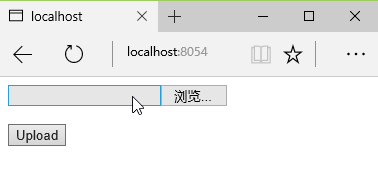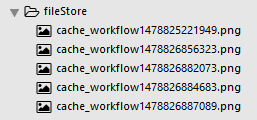 Web Front-end
Web Front-end
 JS Tutorial
JS Tutorial
 Node.js development tutorial: Implementing file upload and verification functions based on the OnceIO framework
Node.js development tutorial: Implementing file upload and verification functions based on the OnceIO framework
Node.js development tutorial: Implementing file upload and verification functions based on the OnceIO framework
OnceIO is the underlying web framework of OnceDoc enterprise content (network disk). It can realize full caching of template files and static files. It does not require I/O operations at all to run, and supports client cache optimization, GZIP compression, etc. (only in First compression), has very good performance, saving you server costs. Its modular function allows your Web to be stored in a distributed manner, that is, an expansion package includes front-end, back-end and database definitions. You can delete functions by adding/deleting directories to achieve true Modular expansion. Here is a series of articles introducing how to use OnceIO.
In this chapter, we will demonstrate how to use OnceIO to implement the file upload function.
Build a form in a web page file
Take a simple web page file.html that only has a file upload function as an example:
<!DOCTYPE html> <html> <body> <form method="post" enctype="multipart/form-data" action="/file/upload"> <input type="file" name="file" /><br> <input type="submit" value="Upload" /> </form> </body> </html>
The browser display effect is like this:

Click on the blank bar or "Browse..." The button can open the file browsing window and select the file to be uploaded:

Establish the server receiving file logic
The server file websvr.js code is like this:
var fs = require('fs')
var path = require('path')
var onceio = require('../onceio/onceio')
var app = onceio()
app.get('/', function(req, res){
res.render('file.html')
})
app.file('/file/upload', function(req, res) {
var fileInfo = req.files.file || {}
fs.link(fileInfo.path, path.join('./fileStore', fileInfo.name))
res.send('File Uploaded Successfully')
}).before(function(req, res) {
var contentLength = req.headers['content-length'] || 0
if (contentLength > 1048576) {
res.send({ error: 'Error: File Size Limit (1 MB) Exceeded' })
} else {
return true
}
})
var fs = require('fs') and var path = require('path') respectively import the file system (fs) module provided by Node.js for operating files and the path module for processing file paths.
app.file(path, callback).before(callback) is equivalent to app.use(path, callback, {file: true}).before(callback) and is a middleware that processes uploaded files.
After the file is uploaded, its size, storage address, name, format and modification time will be placed in the file attribute of req.files (the name is the value of name in the input tag of type 'file') , its size information will be placed in the content-length attribute of req.headers.
before function
before is one of the main differences between OnceIO and other web frameworks. It can perform some basic verification on files before receiving them, such as size, type, etc., in order to obtain the best performance. Return true indicates that the verification is successful and the file starts to be received, otherwise the connection is closed and the upload is cancelled. In before, the req.session object is not available because the session may exist in a file or database redis, and obtaining the session is an asynchronous process that takes time. The before function needs to make an immediate judgment on the legality of the file.
In this example, the before callback function determines whether the uploaded file exceeds the size limit based on the content-length in req.headers (developers can change the upper limit of file upload size by modifying the constant in the if statement. The unit of content-length is byte. , 1024 * 1024 represents 1 MB), if it is exceeded, the file will not be uploaded, and the server will return an error message; if it is not exceeded, the function return value is true, and the server will continue to execute the callback function in app.file to transfer the file from temporary The address is transferred to the specified storage address, and the file is uploaded here.
Solving the problem of duplicate file names
Our current server program cannot solve the problem of duplicate file names. If the user uploads a file with the same name, the server will return an error that the file already exists. In order to solve this problem, we can add a timestamp between the main file name and the extension name of the file. The function code for this processing is as follows:
var timestampName = function(fileName){
// get filename extension
var extName = path.extname(fileName)
// get base name of the file
var baseName = path.basename(fileName, extName)
// insert timestamp between base name and filename extension
// the plus sign ('+') before new Date() converts it into a number
return baseName + +new Date() + extName
}
Then replace fileInfo.name in the fs.link statement with timestampName(fileInfo.name):
fs.link(fileInfo.path, path.join('./fileStore', timestampName(fileInfo.name)))
The improved server program can allow users to upload files with the same name. Take uploading a file named 'cache_workflow.png' 5 times as an example. The file storage address of the server There will be 5 files with names starting with 'cache_workflow' but with different timestamps:

OnceIO address: https://github.com/OnceDoc/onceio
Sample source code: https://github.com /OnceDoc/OnceAcademy/tree/master/Lesson14
The above is the Node.js development tutorial introduced by the editor to implement file upload and verification based on the OnceIO framework. I hope it will be helpful to you. If you have any questions, please Leave me a message and I will reply to you in time. I would also like to thank you all for your support of the PHP Chinese website!
For more Node.js development tutorials on implementing file upload and verification functions based on the OnceIO framework, please pay attention to the PHP Chinese website!

Hot AI Tools

Undresser.AI Undress
AI-powered app for creating realistic nude photos

AI Clothes Remover
Online AI tool for removing clothes from photos.

Undress AI Tool
Undress images for free

Clothoff.io
AI clothes remover

Video Face Swap
Swap faces in any video effortlessly with our completely free AI face swap tool!

Hot Article

Hot Tools

Notepad++7.3.1
Easy-to-use and free code editor

SublimeText3 Chinese version
Chinese version, very easy to use

Zend Studio 13.0.1
Powerful PHP integrated development environment

Dreamweaver CS6
Visual web development tools

SublimeText3 Mac version
God-level code editing software (SublimeText3)

Hot Topics
 1666
1666
 14
14
 1425
1425
 52
52
 1328
1328
 25
25
 1273
1273
 29
29
 1253
1253
 24
24
 JavaScript Engines: Comparing Implementations
Apr 13, 2025 am 12:05 AM
JavaScript Engines: Comparing Implementations
Apr 13, 2025 am 12:05 AM
Different JavaScript engines have different effects when parsing and executing JavaScript code, because the implementation principles and optimization strategies of each engine differ. 1. Lexical analysis: convert source code into lexical unit. 2. Grammar analysis: Generate an abstract syntax tree. 3. Optimization and compilation: Generate machine code through the JIT compiler. 4. Execute: Run the machine code. V8 engine optimizes through instant compilation and hidden class, SpiderMonkey uses a type inference system, resulting in different performance performance on the same code.
 Python vs. JavaScript: The Learning Curve and Ease of Use
Apr 16, 2025 am 12:12 AM
Python vs. JavaScript: The Learning Curve and Ease of Use
Apr 16, 2025 am 12:12 AM
Python is more suitable for beginners, with a smooth learning curve and concise syntax; JavaScript is suitable for front-end development, with a steep learning curve and flexible syntax. 1. Python syntax is intuitive and suitable for data science and back-end development. 2. JavaScript is flexible and widely used in front-end and server-side programming.
 From C/C to JavaScript: How It All Works
Apr 14, 2025 am 12:05 AM
From C/C to JavaScript: How It All Works
Apr 14, 2025 am 12:05 AM
The shift from C/C to JavaScript requires adapting to dynamic typing, garbage collection and asynchronous programming. 1) C/C is a statically typed language that requires manual memory management, while JavaScript is dynamically typed and garbage collection is automatically processed. 2) C/C needs to be compiled into machine code, while JavaScript is an interpreted language. 3) JavaScript introduces concepts such as closures, prototype chains and Promise, which enhances flexibility and asynchronous programming capabilities.
 JavaScript and the Web: Core Functionality and Use Cases
Apr 18, 2025 am 12:19 AM
JavaScript and the Web: Core Functionality and Use Cases
Apr 18, 2025 am 12:19 AM
The main uses of JavaScript in web development include client interaction, form verification and asynchronous communication. 1) Dynamic content update and user interaction through DOM operations; 2) Client verification is carried out before the user submits data to improve the user experience; 3) Refreshless communication with the server is achieved through AJAX technology.
 JavaScript in Action: Real-World Examples and Projects
Apr 19, 2025 am 12:13 AM
JavaScript in Action: Real-World Examples and Projects
Apr 19, 2025 am 12:13 AM
JavaScript's application in the real world includes front-end and back-end development. 1) Display front-end applications by building a TODO list application, involving DOM operations and event processing. 2) Build RESTfulAPI through Node.js and Express to demonstrate back-end applications.
 Understanding the JavaScript Engine: Implementation Details
Apr 17, 2025 am 12:05 AM
Understanding the JavaScript Engine: Implementation Details
Apr 17, 2025 am 12:05 AM
Understanding how JavaScript engine works internally is important to developers because it helps write more efficient code and understand performance bottlenecks and optimization strategies. 1) The engine's workflow includes three stages: parsing, compiling and execution; 2) During the execution process, the engine will perform dynamic optimization, such as inline cache and hidden classes; 3) Best practices include avoiding global variables, optimizing loops, using const and lets, and avoiding excessive use of closures.
 Python vs. JavaScript: Community, Libraries, and Resources
Apr 15, 2025 am 12:16 AM
Python vs. JavaScript: Community, Libraries, and Resources
Apr 15, 2025 am 12:16 AM
Python and JavaScript have their own advantages and disadvantages in terms of community, libraries and resources. 1) The Python community is friendly and suitable for beginners, but the front-end development resources are not as rich as JavaScript. 2) Python is powerful in data science and machine learning libraries, while JavaScript is better in front-end development libraries and frameworks. 3) Both have rich learning resources, but Python is suitable for starting with official documents, while JavaScript is better with MDNWebDocs. The choice should be based on project needs and personal interests.
 Python vs. JavaScript: Development Environments and Tools
Apr 26, 2025 am 12:09 AM
Python vs. JavaScript: Development Environments and Tools
Apr 26, 2025 am 12:09 AM
Both Python and JavaScript's choices in development environments are important. 1) Python's development environment includes PyCharm, JupyterNotebook and Anaconda, which are suitable for data science and rapid prototyping. 2) The development environment of JavaScript includes Node.js, VSCode and Webpack, which are suitable for front-end and back-end development. Choosing the right tools according to project needs can improve development efficiency and project success rate.



